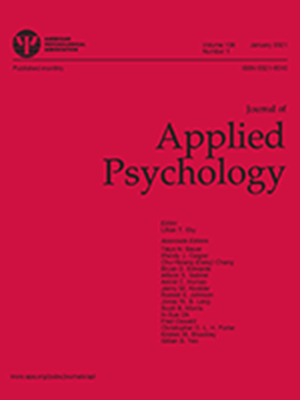The mitigation-signaling model: An integrative conceptual review of allyship behaviors' consequences for marginalized individuals.
IF 6.1
1区 心理学
Q1 MANAGEMENT
引用次数: 0
Abstract
Workplace disparities persist for marginalized individuals-people from groups historically excluded from dominant social, economic, educational, and/or cultural life-who report lower well-being, strained relationships, and worse career outcomes compared to their advantaged counterparts. Allyship behaviors, often defined as actions by advantaged individuals to support marginalized individuals, have been promoted as solutions to such disparities. However, scholarly understanding of allyship behaviors' consequences remains fragmented due to unclear definitions and conceptualizations, a predominant conceptual focus on antecedents, and limited integration with organizational theorizing. Consequently, we develop the mitigation-signaling model, which synthesizes definitions, categorizes behaviors, and disentangles conceptual overlaps to clarify why, how, and when allyship behaviors impact marginalized individuals' work outcomes. The mitigation path focuses on the role of allyship behaviors in reducing mechanisms of disadvantage, that is, interpersonal discrimination, structural discrimination, and unequal access to resources. The signaling path emphasizes socioemotional signals (e.g., social value and safety) that marginalized individuals interpret from allyship behaviors. By bridging allyship and organizational scholarship, we provide a framework that clarifies conceptual boundaries, identifies empirical limitations, and offers a roadmap for advancing theory and practice. Our review highlights opportunities for organizationally relevant research and actionable interventions to address workplace disparities for marginalized individuals. (PsycInfo Database Record (c) 2025 APA, all rights reserved).缓解-信号模型:同盟行为对边缘个体影响的综合概念回顾。
工作场所的差异持续存在于被边缘化的个人身上,这些人来自历史上被排除在主流社会、经济、教育和/或文化生活之外的群体,他们报告说,与优势群体相比,他们的幸福感较低,关系紧张,职业成果更差。同盟行为,通常被定义为优势个体支持边缘个体的行动,已经被推广为解决这种差异的方法。然而,由于定义和概念化不明确,主要关注先行因素的概念,以及与组织理论的有限整合,对盟友行为后果的学术理解仍然支离破碎。因此,我们开发了缓解信号模型,该模型综合了定义,对行为进行了分类,并解开了概念上的重叠,以阐明同盟行为为何、如何以及何时影响边缘化个体的工作成果。缓解路径侧重于同盟行为在减少不利机制(即人际歧视、结构歧视和资源获取不平等)中的作用。信号通路强调边缘化个体从盟友行为中解读的社会情感信号(如社会价值和安全)。通过弥合联盟和组织奖学金,我们提供了一个框架,澄清概念界限,确定经验限制,并提供了推进理论和实践的路线图。我们的回顾强调了组织相关研究和可行干预措施的机会,以解决边缘化个人的工作场所差异。(PsycInfo Database Record (c) 2025 APA,版权所有)。
本文章由计算机程序翻译,如有差异,请以英文原文为准。
求助全文
约1分钟内获得全文
求助全文
来源期刊

Journal of Applied Psychology
Multiple-
CiteScore
17.60
自引率
6.10%
发文量
175
期刊介绍:
The Journal of Applied Psychology® focuses on publishing original investigations that contribute new knowledge and understanding to fields of applied psychology (excluding clinical and applied experimental or human factors, which are better suited for other APA journals). The journal primarily considers empirical and theoretical investigations that enhance understanding of cognitive, motivational, affective, and behavioral psychological phenomena in work and organizational settings. These phenomena can occur at individual, group, organizational, or cultural levels, and in various work settings such as business, education, training, health, service, government, or military institutions. The journal welcomes submissions from both public and private sector organizations, for-profit or nonprofit. It publishes several types of articles, including:
1.Rigorously conducted empirical investigations that expand conceptual understanding (original investigations or meta-analyses).
2.Theory development articles and integrative conceptual reviews that synthesize literature and generate new theories on psychological phenomena to stimulate novel research.
3.Rigorously conducted qualitative research on phenomena that are challenging to capture with quantitative methods or require inductive theory building.
 求助内容:
求助内容: 应助结果提醒方式:
应助结果提醒方式:


